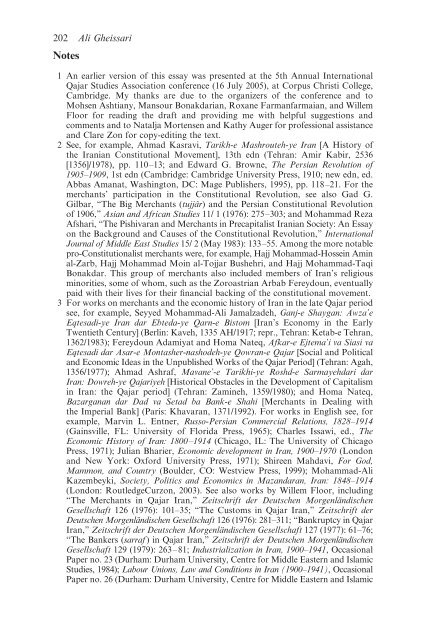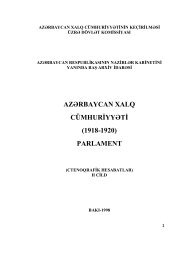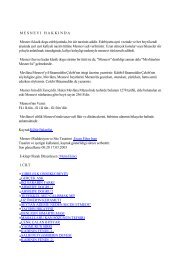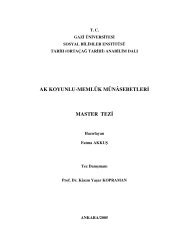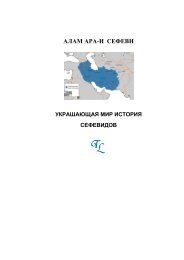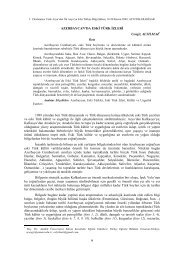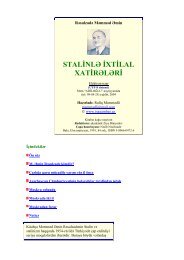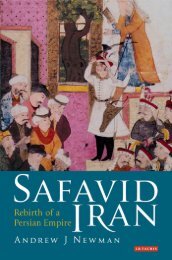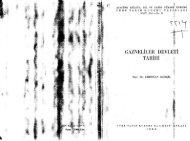Merchants without frontier 201Figure 8.7Jourabchi sisters (daughters of Hajj Hasan, <strong>and</strong> sisters of Hajj Mohammad-Taqi)(photo taken <strong>in</strong> the Pahlavi period, probably 1930s), from right to left:1. Soghra, married to Sadeq Reshad; 2. Robabeh, married to Mohammad-Hosse<strong>in</strong>Partovi; 3. Fatemeh, married to Seyyed Mir-Mohammad Jourabchian-Haqqi;4. Rokhsareh, married to Mohammad-Hossien Har<strong>and</strong>ian; 5. Ma’soumeh,married to Ebrahim ‘Abedi-Fard.anti-constitutionalist clerics. On the other h<strong>and</strong>, given the political dynamics,the very constitutional movement which merchants like the Jourabchibrothers sponsored or went along with, at times adversely impacted theirfortunes. For example, after the Russian ultimatums <strong>in</strong> 1911, a constitutionalistcampaign was waged to boycott the purchase of Russian <strong>and</strong> British goods,along with the use of Russian-owned trams, <strong>and</strong> the Imperial Bank. Theboycott had an adverse impact on transactions by those merchants (constitutionalistor otherwise) who imported Russian or British goods. Also, thebus<strong>in</strong>ess of some merchants on either side of the revolutionary struggle hadperiodically been affected or even ru<strong>in</strong>ed by their political opponents, throughloot<strong>in</strong>g <strong>and</strong> plunder or confiscation <strong>and</strong> extortion.In the social history of the late <strong>Qajar</strong> period, <strong>in</strong>clud<strong>in</strong>g the period of theConstitutional Revolution, the merchants clearly played a significant part.However, it cannot be overtly assumed that all that concerned them dur<strong>in</strong>gthe revolution revolved around the topic of politics; the Jourabchis clearlyfelt otherwise. In our assessment of the constitutional era, <strong>and</strong> <strong>in</strong> order toga<strong>in</strong> a better underst<strong>and</strong><strong>in</strong>g of Iranian society <strong>and</strong> its complexities at the time,this personal/social space deserves to be further studied on its own.
202 Ali GheissariNotes1 An earlier version of this essay was presented at the 5th Annual International<strong>Qajar</strong> Studies Association conference (16 July 2005), at Corpus Christi College,Cambridge. My thanks are due to the organizers of the conference <strong>and</strong> toMohsen Ashtiany, Mansour Bonakdarian, Roxane Farmanfarmaian, <strong>and</strong> WillemFloor for read<strong>in</strong>g the draft <strong>and</strong> provid<strong>in</strong>g me with helpful suggestions <strong>and</strong>comments <strong>and</strong> to Natalja Mortensen <strong>and</strong> Kathy Auger for professional assistance<strong>and</strong> Clare Zon for copy-edit<strong>in</strong>g the text.2 See, for example, Ahmad Kasravi, Tarikh-e Mashrouteh-ye Iran [A History ofthe Iranian Constitutional Movement], 13th edn (Tehran: Amir Kabir, 2536[1356]/1978), pp. 110–13; <strong>and</strong> Edward G. Browne, The <strong>Persia</strong>n Revolution of1905–1909, 1st edn (Cambridge: Cambridge University Press, 1910; new edn, ed.Abbas Amanat, Wash<strong>in</strong>gton, DC: Mage Publishers, 1995), pp. 118–21. For themerchants’ participation <strong>in</strong> the Constitutional Revolution, see also Gad G.Gilbar, “The Big Merchants (tujjâr) <strong>and</strong> the <strong>Persia</strong>n Constitutional Revolutionof 1906,” Asian <strong>and</strong> African Studies 11/ 1 (1976): 275–303; <strong>and</strong> Mohammad RezaAfshari, “The Pishivaran <strong>and</strong> Merchants <strong>in</strong> Precapitalist Iranian Society: An Essayon the Background <strong>and</strong> Causes of the Constitutional Revolution,” InternationalJournal of Middle East Studies 15/ 2 (May 1983): 133–55. Among the more notablepro-Constitutionalist merchants were, for example, Hajj Mohammad-Hosse<strong>in</strong> Am<strong>in</strong>al-Zarb, Hajj Mohammad Mo<strong>in</strong> al-Tojjar Bushehri, <strong>and</strong> Hajj Mohammad-TaqiBonakdar. This group of merchants also <strong>in</strong>cluded members of Iran’s religiousm<strong>in</strong>orities, some of whom, such as the Zoroastrian Arbab Fereydoun, eventuallypaid with their lives for their f<strong>in</strong>ancial back<strong>in</strong>g of the constitutional movement.3 For works on merchants <strong>and</strong> the economic history of Iran <strong>in</strong> the late <strong>Qajar</strong> periodsee, for example, Seyyed Mohammad-Ali Jamalzadeh, Ganj-e Shaygan: Awza’eEqtesadi-ye Iran dar Ebteda-ye Qarn-e Bistom [Iran’s Economy <strong>in</strong> the EarlyTwentieth Century] (Berl<strong>in</strong>: Kaveh, 1335 AH/1917; repr., Tehran: Ketab-e Tehran,1362/1983); Fereydoun Adamiyat <strong>and</strong> Homa Nateq, Afkar-e Ejtema’i va Siasi vaEqtesadi dar Asar-e Montasher-nashodeh-ye Qowran-e <strong>Qajar</strong> [Social <strong>and</strong> Political<strong>and</strong> Economic Ideas <strong>in</strong> the Unpublished Works of the <strong>Qajar</strong> Period] (Tehran: Agah,1356/1977); Ahmad Ashraf, Mavane’-e Tarikhi-ye Roshd-e Sarmayehdari darIran: Dowreh-ye <strong>Qajar</strong>iyeh [Historical Obstacles <strong>in</strong> the Development of Capitalism<strong>in</strong> Iran: the <strong>Qajar</strong> period] (Tehran: Zam<strong>in</strong>eh, 1359/1980); <strong>and</strong> Homa Nateq,B<strong>az</strong>arganan dar Dad va Setad ba Bank-e Shahi [Merchants <strong>in</strong> Deal<strong>in</strong>g withthe Imperial Bank] (Paris: Khavaran, 1371/1992). For works <strong>in</strong> English see, forexample, Marv<strong>in</strong> L. Entner, Russo-<strong>Persia</strong>n Commercial Relations, 1828–1914(Ga<strong>in</strong>sville, FL: University of Florida Press, 1965); Charles Issawi, ed., TheEconomic History of Iran: 1800–1914 (Chicago, IL: The University of ChicagoPress, 1971); Julian Bharier, Economic development <strong>in</strong> Iran, 1900–1970 (London<strong>and</strong> New York: Oxford University Press, 1971); Shireen Mahdavi, For God,Mammon, <strong>and</strong> Country (Boulder, CO: Westview Press, 1999); Mohammad-AliK<strong>az</strong>embeyki, Society, Politics <strong>and</strong> Economics <strong>in</strong> M<strong>az</strong><strong>and</strong>aran, Iran: 1848–1914(London: RoutledgeCurzon, 2003). See also works by Willem Floor, <strong>in</strong>clud<strong>in</strong>g“The Merchants <strong>in</strong> <strong>Qajar</strong> Iran,” Zeitschrift der Deutschen MorgenländischenGesellschaft 126 (1976): 101–35; “The Customs <strong>in</strong> <strong>Qajar</strong> Iran,” Zeitschrift derDeutschen Morgenländischen Gesellschaft 126 (1976): 281–311; “Bankruptcy <strong>in</strong> <strong>Qajar</strong>Iran,” Zeitschrift der Deutschen Morgenländischen Gesellschaft 127 (1977): 61–76;“The Bankers (sarraf ) <strong>in</strong> <strong>Qajar</strong> Iran,” Zeitschrift der Deutschen MorgenländischenGesellschaft 129 (1979): 263–81; Industrialization <strong>in</strong> Iran, 1900–1941, OccasionalPaper no. 23 (Durham: Durham University, Centre for Middle Eastern <strong>and</strong> IslamicStudies, 1984); Labour Unions, Law <strong>and</strong> Conditions <strong>in</strong> Iran (1900–1941), OccasionalPaper no. 26 (Durham: Durham University, Centre for Middle Eastern <strong>and</strong> Islamic
- Page 2 and 3:
War and Peace in Qajar PersiaPersia
- Page 4 and 5:
War and Peace inQajar PersiaImplica
- Page 6 and 7:
ContentsList of figuresContributors
- Page 8 and 9:
Figures5.1 Omani enclaves 1305.2 Ar
- Page 10 and 11:
Contributor listMansoureh Ettehadie
- Page 12:
AcknowledgementsThis volume grew ou
- Page 15 and 16:
2 Roxane Farmanfarmaianrepresented
- Page 17 and 18:
4 Roxane Farmanfarmaianchapter in t
- Page 19 and 20:
6 Roxane FarmanfarmaianThus, two si
- Page 21 and 22:
8 Roxane Farmanfarmaiangaining grea
- Page 23 and 24:
10 Roxane Farmanfarmaiantough deals
- Page 25 and 26:
12 Roxane FarmanfarmaianIranian geo
- Page 27 and 28:
14 Peter W. Averyin Shiraz and cont
- Page 29 and 30:
16 Peter W. Averybut the invasion w
- Page 32:
Part IWar
- Page 35 and 36:
22 Manoutchehr M. Eskandari-Qajarth
- Page 37 and 38:
24 Manoutchehr M. Eskandari-Qajarap
- Page 39 and 40:
26 Manoutchehr M. Eskandari-Qajarmi
- Page 41 and 42:
28 Manoutchehr M. Eskandari-Qajarth
- Page 43 and 44:
30 Manoutchehr M. Eskandari-Qajardo
- Page 45 and 46:
32 Manoutchehr M. Eskandari-QajarIn
- Page 47 and 48:
34 Manoutchehr M. Eskandari-Qajarco
- Page 49 and 50:
36 Manoutchehr M. Eskandari-QajarTh
- Page 51 and 52:
38 Manoutchehr M. Eskandari-Qajarth
- Page 53 and 54:
40 Manoutchehr M. Eskandari-Qajarth
- Page 55 and 56:
42 Manoutchehr M. Eskandari-Qajarop
- Page 57 and 58:
44 Manoutchehr M. Eskandari-Qajarbe
- Page 59 and 60:
46 Manoutchehr M. Eskandari-Qajarva
- Page 61 and 62:
48 Stephanie Cronincapacity and res
- Page 63 and 64:
50 Stephanie Croninforces of the es
- Page 65 and 66:
52 Stephanie CroninPART ONE: THE QA
- Page 67 and 68:
54 Stephanie Croninprincipally on h
- Page 69 and 70:
56 Stephanie CroninThe French offic
- Page 71 and 72:
58 Stephanie CroninEuropean alignme
- Page 73 and 74:
60 Stephanie Croninthe authorities
- Page 75 and 76:
62 Stephanie Croninin the revolutio
- Page 77 and 78:
64 Stephanie Croninof power and sta
- Page 79 and 80:
66 Stephanie Croninliving and the m
- Page 81 and 82:
68 Stephanie Croninconsequences for
- Page 83 and 84:
70 Stephanie Croninrevolution was a
- Page 85 and 86:
72 Stephanie CroninNew British miss
- Page 87 and 88:
74 Stephanie CroninBrigade to a Div
- Page 89 and 90:
76 Stephanie Croninwithout the sove
- Page 91 and 92:
78 Stephanie Croninaccounting devic
- Page 93 and 94:
80 Stephanie Croninbut also faced a
- Page 95 and 96:
82 Stephanie Cronindetermined on th
- Page 97 and 98:
84 Stephanie Cronin15 For a discuss
- Page 99 and 100:
86 Stephanie Cronin55 The Anglo-Rus
- Page 101 and 102:
3 The Turko-Persian War1821-1823Win
- Page 103 and 104:
90 Graham WilliamsonThe resultant w
- Page 105 and 106:
92 Graham Williamsonprovincial forc
- Page 107 and 108:
94 Graham WilliamsonThe field armyO
- Page 109 and 110:
96 Graham Williamsonnot hold out mu
- Page 111 and 112:
98 Graham Williamsonoften in arrear
- Page 113 and 114:
100 Graham Williamsonthan any desig
- Page 115 and 116:
102 Graham WilliamsonThere were ove
- Page 117 and 118:
104 Graham Williamsonone should not
- Page 119 and 120:
Table 3.2 Persian regional armies (
- Page 121 and 122:
108 Graham WilliamsonIranian influe
- Page 123 and 124:
4 Social networks andborder conflic
- Page 125 and 126:
112 Vanessa MartinPersian troops on
- Page 127 and 128:
114 Vanessa Martinof comparatively
- Page 129 and 130:
116 Vanessa MartinTHE ROLE OF SOCIA
- Page 131 and 132:
118 Vanessa MartinThe Shah’s negl
- Page 133 and 134:
120 Vanessa Martinborder or any oth
- Page 135 and 136:
122 Vanessa Martin44 No. 38, 2 June
- Page 138 and 139:
5 The consolidation of Iran’sfron
- Page 140 and 141:
Consolidation of Iran’s frontier
- Page 142 and 143:
Consolidation of Iran’s frontier
- Page 144 and 145:
Consolidation of Iran’s frontier
- Page 146 and 147:
Consolidation of Iran’s frontier
- Page 148 and 149:
Consolidation of Iran’s frontier
- Page 150 and 151:
Figure 5.2 Arab principalities
- Page 152 and 153:
Consolidation of Iran’s frontier
- Page 154 and 155:
Consolidation of Iran’s frontier
- Page 156 and 157:
Consolidation of Iran’s frontier
- Page 158 and 159:
Consolidation of Iran’s frontier
- Page 160 and 161:
Consolidation of Iran’s frontier
- Page 162 and 163:
6 Narrowing the frontierMid-ninetee
- Page 164 and 165: Narrowing the frontier 151witnessed
- Page 166 and 167: Figure 6.1 The 1843 borderlands sta
- Page 168 and 169: Narrowing the frontier 155And the S
- Page 170 and 171: Figure 6.2 The 1850 Williams line a
- Page 172 and 173: Narrowing the frontier 159elicited
- Page 174 and 175: Narrowing the frontier 161travellin
- Page 176 and 177: Narrowing the frontier 163be found
- Page 178 and 179: Narrowing the frontier 165A similar
- Page 180 and 181: Narrowing the frontier 167and accep
- Page 182 and 183: Narrowing the frontier 169Perhaps t
- Page 184 and 185: Narrowing the frontier 171By this s
- Page 186 and 187: Narrowing the frontier 17346 For a
- Page 188 and 189: Crime, security, and insecurity 175
- Page 190 and 191: Crime, security, and insecurity 177
- Page 192 and 193: Crime, security, and insecurity 179
- Page 194 and 195: Crime, security, and insecurity 181
- Page 196 and 197: 8 Merchants without bordersTrade, t
- Page 198 and 199: Merchants without frontier 185the m
- Page 200 and 201: Merchants without frontier 187and d
- Page 202 and 203: Merchants without frontier 189photo
- Page 204 and 205: Merchants without frontier 191their
- Page 206 and 207: Merchants without frontier 193In an
- Page 208 and 209: Figure 8.1Seated, first from left:
- Page 210 and 211: Figure 8.3Seated: Hajj Mohammad-Taq
- Page 212 and 213: Figure 8.5 Taken in Hajj Hasan Jour
- Page 216 and 217: Merchants without frontier 203Studi
- Page 218 and 219: Merchants without frontier 20516 Me
- Page 220 and 221: Merchants without frontier 207and t
- Page 222 and 223: Merchants without frontier 209or pu
- Page 224 and 225: Merchants without frontier 211It ca
- Page 226 and 227: 9 The politics of concessionReasses
- Page 228 and 229: The politics of concession 215gradu
- Page 230 and 231: The politics of concession 217Shah,
- Page 232 and 233: The politics of concession 219assig
- Page 234 and 235: The politics of concession 221compa
- Page 236 and 237: The politics of concession 223gross
- Page 238 and 239: The politics of concession 225the B
- Page 240 and 241: The politics of concession 227as th
- Page 242 and 243: IndexAbbas Mirza, Crown Prince 6, 1
- Page 244 and 245: Index 231Gulf Arabs 127-9Gwadar 136
- Page 246 and 247: Index 233policy in Persian Gulf 131


